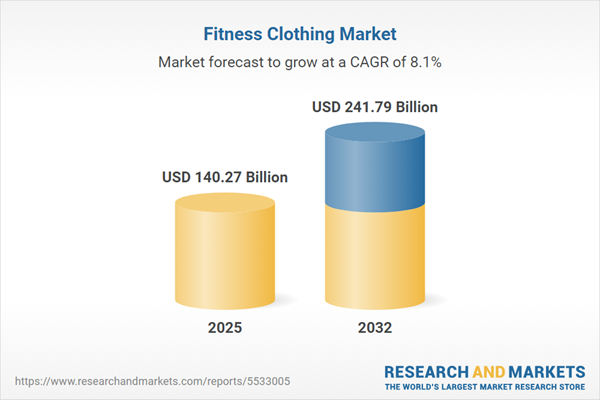Speak directly to the analyst to clarify any post sales queries you may have.
The fitness clothing market is experiencing ongoing transformation, shaped by digital innovation and evolving consumer behaviors. Executives navigating this sector must respond to rapid shifts, drive sustainable initiatives, and maintain organizational agility to remain relevant.
Market Snapshot: Fitness Clothing Market Overview
The global fitness clothing market demonstrates steady growth, underpinned by a consistently strong compound annual growth rate seen in recent reporting. This expansion is influenced by rising consumer interest in health and wellness, increasing urban activity levels, and the accelerating digitalization of retail channels. Companies are investing in more robust digital infrastructure to analyze evolving trends and manage inventory efficiently, applying advanced consumer analytics to deliver tailored product experiences. These actions help brands satisfy dynamic consumer demands, making the fitness clothing market essential for organizations developing competitive strategies in a rapidly changing landscape.
Scope & Segmentation of the Fitness Clothing Market
- Product Types: Performance-driven apparel and adaptable clothing, including outerwear, tops, bottoms, underwear, and specialty accessories meet both athletic and everyday requirements, supporting a versatile consumer base.
- Accessories: Practical items such as bags, caps, and socks integrate both utility and style, enhancing functionality for active and casual users alike.
- Gender Segments: Dedicated lines address the preferences of men, women, and unisex audiences with individualized sizing and inclusive designs, widening market reach.
- Activity Segments: Garments designed for activities like running, training, yoga, and wellness promote continual product differentiation, aligning with changing fitness routines and interests.
- Material Types: The use of natural, blended, and synthetic fibers demonstrates an ongoing commitment to sustainable sources while optimizing performance through technical textile development.
- Distribution Channels: Omnichannel models spanning department stores, specialty retailers, ecommerce, sports outlets, and third-party marketplaces ensure consumers can access products seamlessly where they shop most.
- Regional Coverage: Responsive localization strategies accommodate specific climate, regulatory, and consumer needs across the Americas, Europe, Middle East, Africa, and Asia-Pacific, enabling targeted product adaptations.
- Key Companies Profiled: Sector-leading organizations such as Nike, adidas, PUMA, Under Armour, Lululemon, ASICS, New Balance, Gymshark, Columbia Sportswear, and Fila Korea continue to set standards and drive innovation throughout the market.
Key Strategic Takeaways for Senior Decision-Makers
- Adopt adaptive product design, balancing performance needs with lifestyle appeal to serve expanding and diverse customer segments in the fitness clothing market.
- Invest in sustainable fabric sourcing and integrate advanced textile technologies that align with modern consumer expectations for quality and environmental responsibility.
- Pursue ethical procurement practices and circular production models, building stronger supply chain resilience and proactive compliance with shifting stakeholder and regulatory expectations.
- Deploy digital engagement tools, such as virtual try-ons and interactive content, to enhance consumer interaction and improve the efficiency of online conversion strategies.
- Strengthen partnerships with technology providers and professional athletes to amplify product visibility and create clear points of differentiation that reinforce brand positioning and trust.
- Maintain seamless omnichannel alignment, connecting with knowledgeable, value-driven buyers at every touchpoint while reinforcing consistent brand experiences across retail environments.
Tariff Impact and Sourcing Dynamics
Changing US import tariffs on textiles and apparel have prompted market participants to develop agile sourcing strategies. Broadening supplier networks, emphasizing local procurement, and reinforcing fiber supplier relationships are critical measures. These steps enable organizations to control costs, secure consistent quality, and maintain reliable supply in response to shifting policy and regulatory pressures.
Methodology & Data Sources
This analysis draws on insights from sector executives and experienced product designers, alongside curated market data and peer-reviewed sources. Proven analytical methods underpin the extraction of relevant intelligence, providing senior leaders in the sector with clear and actionable insights.
Why This Report Matters
- Enables senior teams to pinpoint lucrative growth areas and shape data-informed strategies by product, region, and channel.
- Offers practical guidance for navigating supply chain volatility and adapting to regulatory change for heightened resilience.
- Facilitates the shift toward sustainable, digitally integrated business models that keep pace with advanced consumer preferences and technology trends.
Conclusion
The fitness clothing market’s future depends on continuous innovation, strong digital engagement, and operational flexibility. This report equips leaders to address market complexity, define effective strategy, and support ongoing performance in a shifting global context.
Additional Product Information:
- Purchase of this report includes 1 year online access with quarterly updates.
- This report can be updated on request. Please contact our Customer Experience team using the Ask a Question widget on our website.
Table of Contents
3. Executive Summary
4. Market Overview
7. Cumulative Impact of Artificial Intelligence 2025
Companies Mentioned
The companies profiled in this Fitness Clothing market report include:- Nike, Inc.
- adidas AG
- PUMA SE
- Under Armour, Inc.
- Lululemon Athletica Inc.
- ASICS Corporation
- New Balance Athletics, Inc.
- Gymshark Limited
- Columbia Sportswear Company
- Fila Korea Ltd.
Table Information
| Report Attribute | Details |
|---|---|
| No. of Pages | 180 |
| Published | October 2025 |
| Forecast Period | 2025 - 2032 |
| Estimated Market Value ( USD | $ 140.27 Billion |
| Forecasted Market Value ( USD | $ 241.79 Billion |
| Compound Annual Growth Rate | 8.0% |
| Regions Covered | Global |
| No. of Companies Mentioned | 11 |









